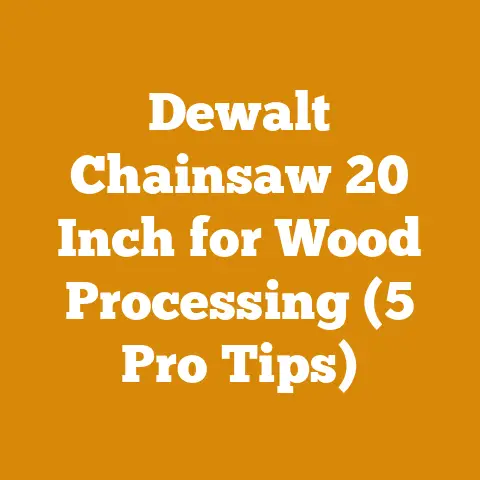Poulan Pro 42cc Chainsaw Fuel Line Diagram (5 Expert Tips)
Understanding the Poulan Pro 42cc Fuel System
Before diving into the diagram and troubleshooting, it’s vital to understand the basics of the fuel system in your Poulan Pro 42cc chainsaw. The fuel system is responsible for delivering the correct mixture of fuel and air to the engine, allowing it to run smoothly and efficiently. The key components include:
- Fuel Tank: Holds the fuel mixture (typically gasoline and 2-cycle oil).
- Fuel Filter: Located inside the fuel tank, it filters debris from the fuel before it enters the fuel line.
- Fuel Lines: Hoses that carry fuel from the tank to the carburetor and back. There are usually two or three fuel lines: one to supply fuel to the carburetor, one to return excess fuel to the tank (the return line), and sometimes a primer line.
- Carburetor: Mixes fuel and air in the correct proportions for combustion.
- Primer Bulb: A small bulb that, when pressed, draws fuel from the tank and primes the carburetor for easier starting.
Why Fuel Lines Matter
Fuel lines are more than just simple tubes. They need to be fuel-resistant, flexible enough to withstand vibration, and durable enough to handle temperature changes. Over time, exposure to fuel, heat, and the elements can cause them to harden, crack, and leak. A faulty fuel line can lead to a host of problems, including:
- Hard starting
- Poor performance
- Engine stalling
- Fuel leaks (a fire hazard!)
Poulan Pro 42cc Chainsaw Fuel Line Diagram
While diagrams can vary slightly depending on the specific model year of your Poulan Pro 42cc, the general layout is consistent. Here’s a breakdown of a typical fuel line configuration:
- Fuel Tank: The starting point. Note the location of the fuel filter inside the tank.
- Fuel Filter: Attached to one end of the fuel line inside the tank.
- Main Fuel Line (Tank to Carburetor): Runs from the fuel filter to the carburetor’s fuel inlet. This is usually the longer of the two lines originating from the tank.
- Return Fuel Line (Carburetor to Tank): Returns excess fuel from the carburetor back to the fuel tank. This line is typically shorter and connects to a fitting near the top of the fuel tank.
- Primer Line (Primer Bulb to Carburetor): Connects the primer bulb to the carburetor. This line is often shorter and smaller in diameter than the main fuel line.
Visual Aid: Imagine the fuel tank as the heart of the system. The main fuel line is like an artery carrying fuel to the engine (carburetor), and the return line is like a vein returning excess fuel to the heart. The primer line is a small bypass, helping to prime the system for startup.
5 Expert Tips for Fuel Line Diagnosis and Repair
Based on my years of experience working with chainsaws, here are five expert tips to help you diagnose and repair fuel line issues on your Poulan Pro 42cc chainsaw:
Tip 1: Visual Inspection is Key
The Strategy: Before tearing anything apart, carefully inspect all the fuel lines. Look for cracks, kinks, hardening, or signs of fuel leakage. Pay close attention to the areas where the lines connect to the fuel tank, carburetor, and primer bulb. These are common points of failure.
My Experience: I once spent an hour troubleshooting a chainsaw that wouldn’t start, only to discover a tiny crack in the fuel line right where it connected to the carburetor. The crack was so small it was almost invisible, but it was enough to prevent the engine from drawing fuel.
Actionable Steps:
- Remove the air filter and inspect the fuel lines around the carburetor.
- Carefully examine the fuel lines inside the fuel tank. You may need to use a small flashlight to get a good view.
- Gently bend the fuel lines to check for cracking or hardening. If the lines feel stiff and brittle, they likely need to be replaced.
Measurement: Use a magnifying glass to inspect for hairline cracks that may not be visible to the naked eye.
Takeaway: A thorough visual inspection can often pinpoint the problem quickly and save you a lot of time and frustration.
Tip 2: The “Bubble Test” for Leak Detection
The Strategy: If you suspect a leak but can’t find it visually, the “bubble test” is a simple and effective way to identify the source.
How It Works:
- Empty the fuel tank completely.
- Mix a solution of soapy water (dish soap works well).
- Use a small brush or spray bottle to apply the soapy water to the fuel lines and connections.
- Use compressed air (from a can or a compressor) to gently pressurize the fuel tank through the fuel cap opening. Be careful not to over-pressurize.
- Watch for bubbles forming on the fuel lines or connections. Bubbles indicate a leak.
My Insight: I’ve used this technique countless times to find elusive leaks in fuel systems. It’s particularly helpful for identifying leaks in hard-to-reach areas.
Actionable Steps:
- Ensure the fuel tank is completely empty before starting.
- Use a low-pressure air source to avoid damaging the fuel lines.
- Pay close attention to the connections at the fuel tank, carburetor, and primer bulb.
Data Point: A leak as small as 0.5 mm in diameter can cause significant starting and performance problems.
Takeaway: The bubble test is a reliable method for pinpointing fuel leaks that may not be visible to the naked eye.
Tip 3: Choosing the Right Fuel Line Replacement
The Strategy: Not all fuel lines are created equal. When replacing fuel lines, it’s crucial to use the correct type and size for your Poulan Pro 42cc chainsaw.
Why It Matters: Using the wrong type of fuel line can lead to premature failure, fuel leaks, and even engine damage.
Key Considerations:
- Material: Look for fuel lines specifically designed for use with gasoline and 2-cycle oil mixtures. Common materials include Tygon and Viton.
- Size: Match the inside diameter (ID) of the original fuel lines. Using a fuel line that is too small can restrict fuel flow, while one that is too large may not seal properly.
- Length: Cut the new fuel lines to the correct length. Avoid using excessively long lines, as they can kink or become tangled.
My Recommendation: I always recommend using high-quality Tygon fuel lines. They are durable, flexible, and resistant to fuel degradation.
Actionable Steps:
- Consult your Poulan Pro 42cc chainsaw’s owner’s manual for the correct fuel line size specifications.
- Measure the inside diameter of the old fuel lines before discarding them.
- Purchase fuel lines from a reputable supplier to ensure quality.
Measurement: Common fuel line sizes for small engines range from 1/8″ ID to 3/16″ ID.
Takeaway: Using the correct fuel line replacement is essential for ensuring the long-term reliability of your chainsaw’s fuel system.
Tip 4: Mastering the Fuel Line Installation
The Strategy: Installing fuel lines correctly is just as important as choosing the right replacement. A poorly installed fuel line can leak, kink, or become disconnected.
Tools You’ll Need:
- Needle-nose pliers
- Small screwdriver
- Utility knife or sharp scissors
- Lubricant (e.g., silicone spray or WD-40)
Installation Steps:
- Remove the Old Fuel Lines: Carefully disconnect the old fuel lines from the fuel tank, carburetor, and primer bulb. Use needle-nose pliers to gently loosen the lines if necessary.
- Prepare the New Fuel Lines: Cut the new fuel lines to the correct length. Angle the cut slightly to make it easier to insert the lines into the fittings.
- Lubricate the Fittings: Apply a small amount of lubricant to the fittings on the fuel tank, carburetor, and primer bulb. This will make it easier to slide the fuel lines onto the fittings.
- Install the Fuel Lines: Carefully push the fuel lines onto the fittings. Ensure the lines are fully seated and securely connected.
- Route the Fuel Lines: Route the fuel lines so they are not kinked or pinched. Use zip ties or cable clamps to secure the lines if necessary.
My Pro Tip: I often use a small screwdriver to gently widen the end of the fuel line before installing it onto the fitting. This makes it easier to slide the line onto the fitting without damaging it.
Actionable Steps:
- Work in a well-lit area.
- Take your time and be careful not to damage the fuel lines or fittings.
- Double-check all connections to ensure they are secure.
Measurement: Ensure the fuel lines are seated at least 1/4″ onto the fittings for a secure connection.
Takeaway: Proper fuel line installation is crucial for preventing leaks and ensuring the reliable operation of your chainsaw.
Tip 5: Primer Bulb and Fuel Filter Considerations
The Strategy: While you’re working on the fuel lines, it’s a good idea to inspect the primer bulb and fuel filter. These components are often overlooked but can cause significant problems if they are faulty.
Primer Bulb Inspection:
- Check for Cracks or Damage: Look for cracks, tears, or other signs of damage to the primer bulb. A damaged primer bulb will not draw fuel properly.
- Test the Bulb’s Function: Press the primer bulb several times. You should feel it fill with fuel and then return to its original shape. If the bulb feels hard or doesn’t return to its shape, it may be clogged or damaged.
Fuel Filter Inspection:
- Check for Clogging: Remove the fuel filter from the fuel tank and inspect it for debris. A clogged fuel filter will restrict fuel flow and cause starting problems.
- Replace the Filter Regularly: I recommend replacing the fuel filter at least once a year, or more often if you use your chainsaw frequently.
My Experience: I once had a chainsaw that was running poorly, and I couldn’t figure out why. After replacing the fuel lines, I decided to inspect the fuel filter, and it was completely clogged with debris. Replacing the filter solved the problem instantly.
Actionable Steps:
- Replace the primer bulb if it is cracked, damaged, or not functioning properly.
- Clean or replace the fuel filter if it is clogged.
- Use a fuel stabilizer in your fuel mixture to prevent fuel degradation and clogging.
Data Point: A clogged fuel filter can reduce fuel flow by as much as 50%, leading to significant performance problems.
Takeaway: Don’t overlook the primer bulb and fuel filter when troubleshooting fuel system problems. These components are essential for proper fuel delivery.
Advanced Troubleshooting: When the Basics Aren’t Enough
Sometimes, even after replacing the fuel lines, primer bulb, and fuel filter, you may still experience problems with your Poulan Pro 42cc chainsaw. Here are some advanced troubleshooting tips to consider:
Carburetor Issues
The Problem: The carburetor is responsible for mixing fuel and air in the correct proportions. If the carburetor is dirty, clogged, or out of adjustment, it can cause a variety of problems, including hard starting, poor performance, and engine stalling.
Troubleshooting Steps:
- Clean the Carburetor: Use carburetor cleaner to clean the carburetor’s jets and passages.
- Adjust the Carburetor: Consult your owner’s manual for the correct carburetor adjustment settings.
- Rebuild the Carburetor: If cleaning and adjusting the carburetor doesn’t solve the problem, you may need to rebuild it with a carburetor rebuild kit.
My Insight: Carburetors are complex devices, and it’s easy to damage them if you’re not careful. If you’re not comfortable working on carburetors, it’s best to take your chainsaw to a qualified repair shop.
Ignition System Problems
The Problem: The ignition system is responsible for providing the spark that ignites the fuel-air mixture in the engine. If the ignition system is faulty, the engine may not start or may run poorly.
Troubleshooting Steps:
- Check the Spark Plug: Remove the spark plug and inspect it for damage or fouling. Replace the spark plug if necessary.
- Test the Ignition Coil: Use a spark tester to check the ignition coil’s output. If the coil is not producing a strong spark, it may need to be replaced.
- Check the Wiring: Inspect the wiring for damage or loose connections.
My Experience: I once spent hours troubleshooting a chainsaw that wouldn’t start, only to discover that the spark plug wire had come loose from the spark plug. A simple reconnection solved the problem.
Compression Issues
The Problem: The engine’s compression is the pressure created inside the cylinder when the piston moves upward. If the engine has low compression, it may not start or may run poorly.
Troubleshooting Steps:
- Perform a Compression Test: Use a compression tester to measure the engine’s compression. A healthy engine should have a compression reading of at least 100 PSI.
- Check for Leaks: Listen for air leaks around the cylinder head, base gasket, and spark plug.
- Inspect the Piston and Rings: If the engine has low compression and you suspect a problem with the piston or rings, you may need to disassemble the engine for further inspection.
My Recommendation: Compression issues are often a sign of serious engine wear or damage. If your chainsaw has low compression, it may be time to consider replacing it.
Safety First: Working with Fuel and Chainsaws
Working with fuel and chainsaws can be dangerous if you’re not careful. Always follow these safety precautions:
- Work in a Well-Ventilated Area: Fuel vapors are flammable and can be harmful to your health.
- Wear Safety Glasses: Protect your eyes from flying debris.
- Wear Gloves: Protect your hands from fuel and sharp objects.
- Disconnect the Spark Plug Wire: Before working on the fuel system, disconnect the spark plug wire to prevent accidental starting.
- Keep a Fire Extinguisher Nearby: Be prepared to extinguish a fire if one should occur.
- Read and Follow the Owner’s Manual: The owner’s manual contains important safety information.
Maintaining Your Poulan Pro 42cc for Longevity
Preventive maintenance is key to ensuring the long-term reliability of your Poulan Pro 42cc chainsaw. Here are some tips:
- Use Fresh Fuel: Use fresh, high-quality gasoline and 2-cycle oil.
- Use Fuel Stabilizer: Add fuel stabilizer to your fuel mixture to prevent fuel degradation and clogging.
- Clean the Air Filter Regularly: A dirty air filter can restrict airflow and cause engine problems.
- Sharpen the Chain Regularly: A sharp chain cuts more efficiently and reduces strain on the engine.
- Lubricate the Chain Regularly: Use chain oil to keep the chain lubricated and prevent wear.
- Store Your Chainsaw Properly: Store your chainsaw in a dry, protected location.
- Follow the Maintenance Schedule: Consult your owner’s manual for the recommended maintenance schedule.
Conclusion: Fuel Line Mastery and Beyond
By understanding the fuel system of your Poulan Pro 42cc chainsaw, diagnosing fuel line issues effectively, and following the expert tips I’ve shared, you can keep your chainsaw running smoothly and efficiently for years to come. Remember, a little preventative maintenance can go a long way in preventing costly repairs and ensuring your chainsaw is ready when you need it most. As the winter months approach, a well-maintained chainsaw is your best friend for tackling firewood preparation and other essential tasks. So, take the time to inspect your fuel lines, address any issues, and enjoy the satisfaction of a job well done. Now, get out there and make some firewood!






